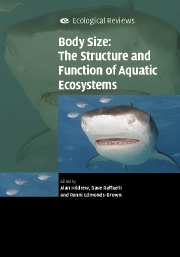Book contents
- Frontmatter
- Contents
- List of contributors
- Preface
- 1 The metabolic theory of ecology and the role of body size in marine and freshwater ecosystems
- 2 Body size and suspension feeding
- 3 Life histories and body size
- 4 Relationship between biomass turnover and body size for stream communities
- 5 Body size in streams: macroinvertebrate community size composition along natural and human-induced environmental gradients
- 6 Body size and predatory interactions in freshwaters: scaling from individuals to communities
- 7 Body size and trophic cascades in lakes
- 8 Body size and scale invariance: multifractals in invertebrate communities
- 9 Body size and biogeography
- 10 By wind, wings or water: body size, dispersal and range size in aquatic invertebrates
- 11 Body size and diversity in marine systems
- 12 Interplay between individual growth and population feedbacks shapes body-size distributions
- 13 The consequences of body size in model microbial ecosystems
- 14 Body size, exploitation and conservation of marine organisms
- 15 How body size mediates the role of animals in nutrient cycling in aquatic ecosystems
- 16 Body sizes in food chains of animal predators and parasites
- 17 Body size in aquatic ecology: important, but not the whole story
- Index
- References
11 - Body size and diversity in marine systems
Published online by Cambridge University Press: 02 December 2009
- Frontmatter
- Contents
- List of contributors
- Preface
- 1 The metabolic theory of ecology and the role of body size in marine and freshwater ecosystems
- 2 Body size and suspension feeding
- 3 Life histories and body size
- 4 Relationship between biomass turnover and body size for stream communities
- 5 Body size in streams: macroinvertebrate community size composition along natural and human-induced environmental gradients
- 6 Body size and predatory interactions in freshwaters: scaling from individuals to communities
- 7 Body size and trophic cascades in lakes
- 8 Body size and scale invariance: multifractals in invertebrate communities
- 9 Body size and biogeography
- 10 By wind, wings or water: body size, dispersal and range size in aquatic invertebrates
- 11 Body size and diversity in marine systems
- 12 Interplay between individual growth and population feedbacks shapes body-size distributions
- 13 The consequences of body size in model microbial ecosystems
- 14 Body size, exploitation and conservation of marine organisms
- 15 How body size mediates the role of animals in nutrient cycling in aquatic ecosystems
- 16 Body sizes in food chains of animal predators and parasites
- 17 Body size in aquatic ecology: important, but not the whole story
- Index
- References
Summary
Introduction
Much has been written concerning the relationship between body size and biological traits, mostly concerning the terrestrial situation. There is no reason to suppose that many of these relationships will be different in the sea; for example quarter-power scaling with body mass applies to virtually all organisms (West, Brown & Enquist, 1999). For marine animals, metabolic rate and production scales at three-quarters power (e.g. Brey, 1990; Warwick & Price, 1979), while it is likely that life span increases in proportion to body mass raised to the power of one quarter, although so little is known about the natural history of marine animals that this latter relationship cannot yet be established. On the other hand, the very different phyletic composition of terrestrial and marine faunas, and the big differences in life-history characteristics, suggest that relationships between body size and diversity will differ between these two realms.
The relationship between body size and diversity is fraught with uncertainties and inconsistencies. Hutchinson (1959) suggested that ‘… small size, by permitting animals to become specialised to the conditions offered by small diversified elements of the environmental mosaic, clearly makes possible a degree of diversity quite unknown among groups of larger organisms’. However, it is now suggested that the spatial and temporal structure of the physical environment is fractal (Bell et al., 1993 and references therein; see Schmid & Schmid-Araya, this volume), and if habitat complexity largely determines species diversity this leads to the prediction (for a single perfect fractal) that all organisms, regardless of size, will perceive the environment as equally complex and should have equivalent diversity.
- Type
- Chapter
- Information
- Body Size: The Structure and Function of Aquatic Ecosystems , pp. 210 - 224Publisher: Cambridge University PressPrint publication year: 2007
References
- 6
- Cited by



